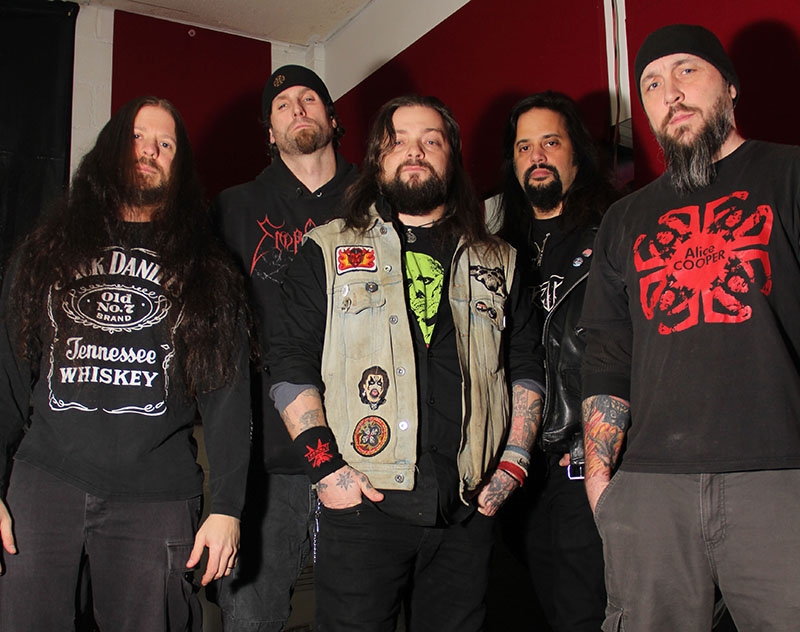
(L–R) John Comprix, Dan Zink, Human Furnace, Ed Stephens and Matt Sorg will unleash Ringworm’s 16th release on March 18 on Relapse. Photo courtesy of Scott Schumacher
The Asylum Door Opens: Ringworm Return to SLC
Music Interviews
I’ve been chatting with James “The Human Furnace” Bulloch for just a few minutes. We’ve touched on Cleveland, the ’90s hardcore scene and his band Ringworm’s place within it. Right now, though, all I can focus on is the fact that King Diamond’s already been brought up twice. “I really had nothing in common with my peers at the time,” says Bulloch, reflecting on the band’s genesis and the hardcore scene of the time. “I never felt like singing about ‘the scene’ or ‘my friend stabbed me in the back.’”
That’s always been Ringworm’s deal, though. A little bit o’ hardcore and a whole heaping of metal, it’s a style that came from Bulloch’s upbringing as the youngest of four music-obsessed kids. The divergent household sounds of Conway Twitty, Deep Purple, Alice Cooper and ‘80s hardcore all seeped into the formula, a writhing cuisinart of noise, power and expressive aural art that’s been perpetuating the distinctive Ringworm sound since Day One.
When hardcore started to take hold in the early 1990s, many bands of the ilk shed the free-form expressiveness of their ‘80s torchbearers, opting for a more codified and militant strain of punk that incorporated animal rights, straight edge and even Eastern religion into the casserole. Breakdowns got heavier, album art more sparse, scenes more stratified and lyrics a lot more topical. Still, Ringworm stayed immune. “I was more enamored with the King Diamond, Slayer or Venom style of imagery,” Bulloch says. “Stuff where you could paint a picture with your words.”
The damning madness of war, the psychological torment of drug addiction and the seething hypocrisy of organized religion became viable Ringworm song themes, as the group of self-described “freaks” began co-opting their acrid blend of early Earache Records and thrash riffs with the nascent sound of the rapidly developing Cleveland hardcore scene. Owed in no small part to early guitarist Frank “3 Gun” Novinec’s love of teutonic thrash riffs, and Bulloch’s metaphor-laden lyrics (and an unholy voice that could ice blood straight over), Ringworm rose to prominence in a scene that had already earned its own acclaim with bands like Confront, Face Value and, of course, Integrity, releasing triumphant and genre-defining records like Birth is Pain, The Promise and Justice Replaced by Revenge, and collecting a rabid, worldwide audience.
In that regard, the city of Cleveland is just as vital to Ringworm’s legacy as their unique musical flavorings. An industrial Midwest city, far from the cultural art centers of Los Angeles, San Francisco, New York and the ritzy college establishments of New England, Cleveland could incubate its own brand of left-of-center chicanery, allowing unfettered access to punks, skins, longhairs, jocks and general lunatics alike. “It’s cold and shitty here—the sports teams suck,” says Bulloch. “It’s easy for it all to rub off on you and feel like a loser.” This kind of access to an unrestricted stream of mutant art gave Bulloch and his peers a platform from which to spread their gospel, a vehicle to access a world far greater than their own.
And they just never stopped. Since 1998, the band’s been steadily releasing records and charting tours, playing fests and one-offs to the die-hards that support them. Maybe it’s cliché to speak in terms of “longevity” here, but in a time where virtually every ‘core band with four songs to rub together has been re-engaging the “reunion” shtick to get a quick run at nostalgic pop, Ringworm’s been honing their craft, evolving in their own right, without all the fanfare. It doesn’t bother Bulloch, though. “We’re too dumb to quit, and we love what we’re doing,” he says with a laugh.
Hammer of the Witch is the band’s newest offering, which releases March 18 on Relapse. The title and much of the lyrical output is based on a painting that Bulloch curated for a Cleveland-based art show, and one that will surely expose them to a new subset of fans, having spent much of their career on labels like Victory, Deathwish and A389. The new record will take them to the Metal Sucks showcase at SXSW, putting Ringworm on a bill and stage outside their element. “We’re up for it, though. I like not knowing what to expect,” says Bulloch. “Sometimes the shows are so personal and intense that I go overboard and freak people out. I enjoy that.”
If there’s one place Ringworm’s always found acceptance, it’s right here in Salt Lake City. “The first time we were there, it was a chaotic madhouse. The crowd was going bananas, as if someone had left open the doors to the asylum,” says Bulloch. “It was awesome.” Even in the thickened midst of this city’s infamous (and somewhat media fabricated) militant straight edge obsession, the band (self-described party-ers and occasional indulgers) took immediate hold, appealing to fringe core-cretins and dyed-in-the-wool heshers, and it’s this reason that the band re-routed their trip for a10-hour detour just to play here.
Yes, we love hardcore. We love its starkness and its realism and its dismissal of pomp and everything else that is vile and bloated about “rock culture,” but can we just admit that we dig a good spectacle? Maybe a little mystery? A little bit of “Will they? Won’t they?” Sure we do. We all do. That’s why we love Ringworm, and that’s why we can’t wait for them to come back.
Experience it in person, April 14 at The Shred Shed on a co-headlining slot with Death Before Dishonor.